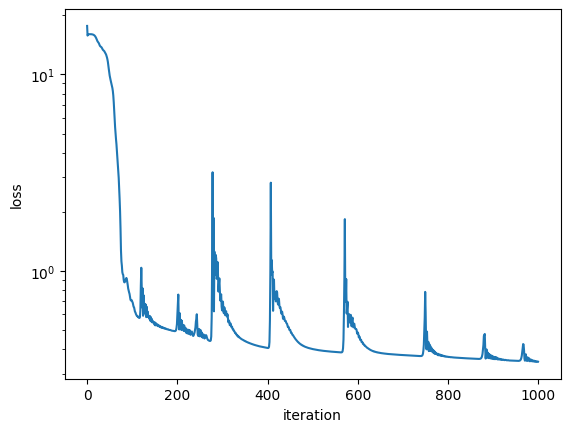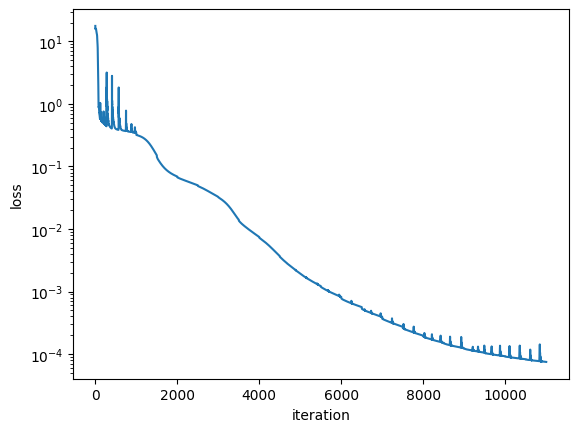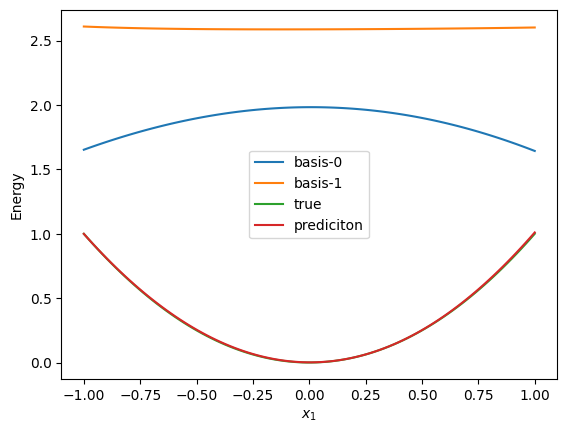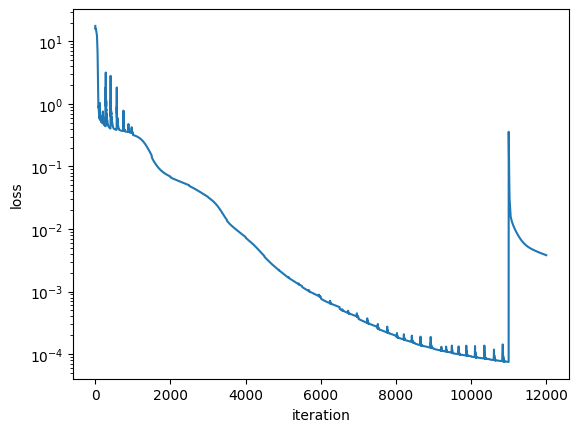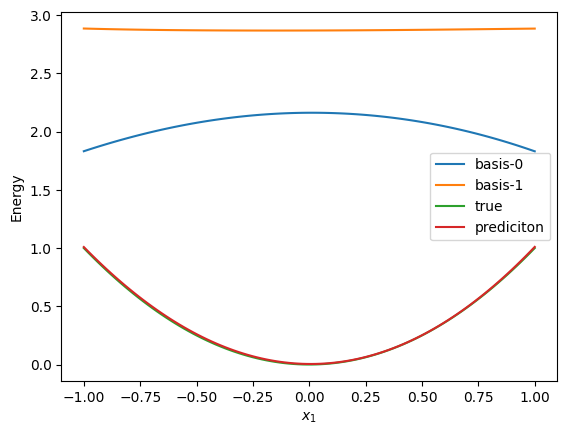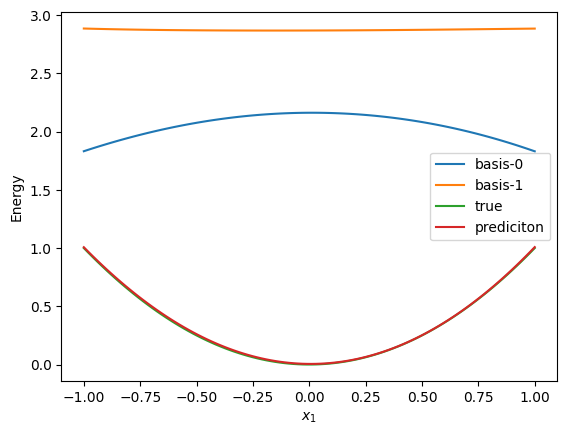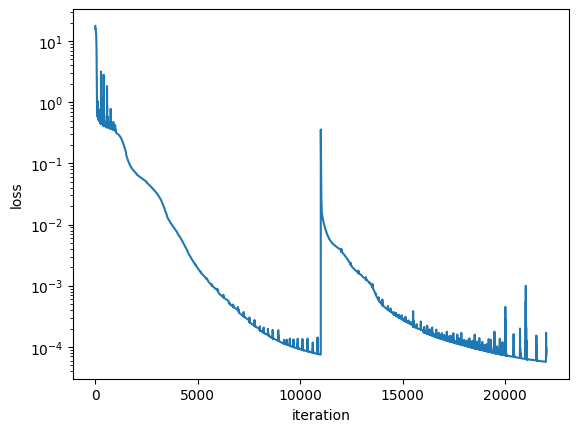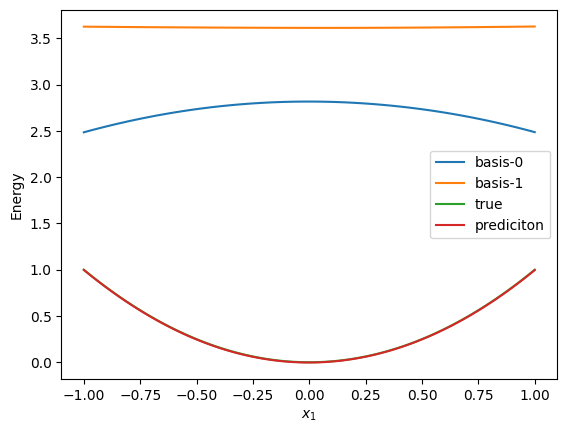Custom neural network combined with tensor train
Let’s hacking Pompon!
One will use tensor train implementaion in Pompon and customized neural network build by Flax
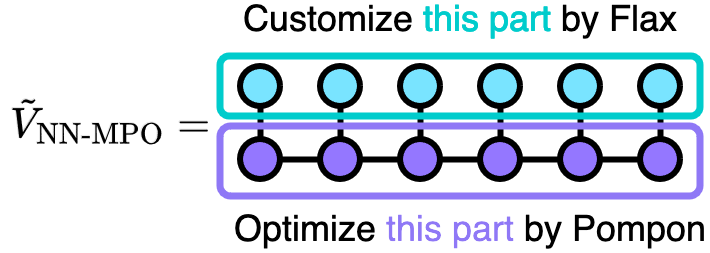
Before start, install Flax. In this example, we will follow flax.nnx API rather than flax.linen API.
Import modules
Prepare training data
We will use \[ y = \boldsymbol{x}A\boldsymbol{x}^\top \] as a true function
Code
def generate_data(num_samples, key, include_f=True):
mean = jnp.zeros(3)
cov = jnp.eye(3)
k = 1.0
A = k * jnp.linalg.inv(cov)
x_samples = jax.random.multivariate_normal(
key=key, mean=mean, cov=cov, shape=(num_samples,), dtype=DTYPE
)
y_samples = jnp.einsum("ni,ij,nj->n", x_samples, A, x_samples)
if include_f:
f_samples = -2.0 * x_samples @ A
return x_samples, y_samples[:, jnp.newaxis], f_samples
else:
return x_samples, y_samples[:, jnp.newaxis]
num_samples = 256
key = jax.random.PRNGKey(0)
x_samples, y_samples, f_samples = generate_data(num_samples, key)
print("x samples:", x_samples.shape, x_samples.dtype)
print("y samples:", y_samples.shape, y_samples.dtype)
print("f samples:", f_samples.shape, f_samples.dtype)x samples: (256, 3) float64
y samples: (256, 1) float64
f samples: (256, 3) float64Define Custom Network
Define Basis function
Define network like this;
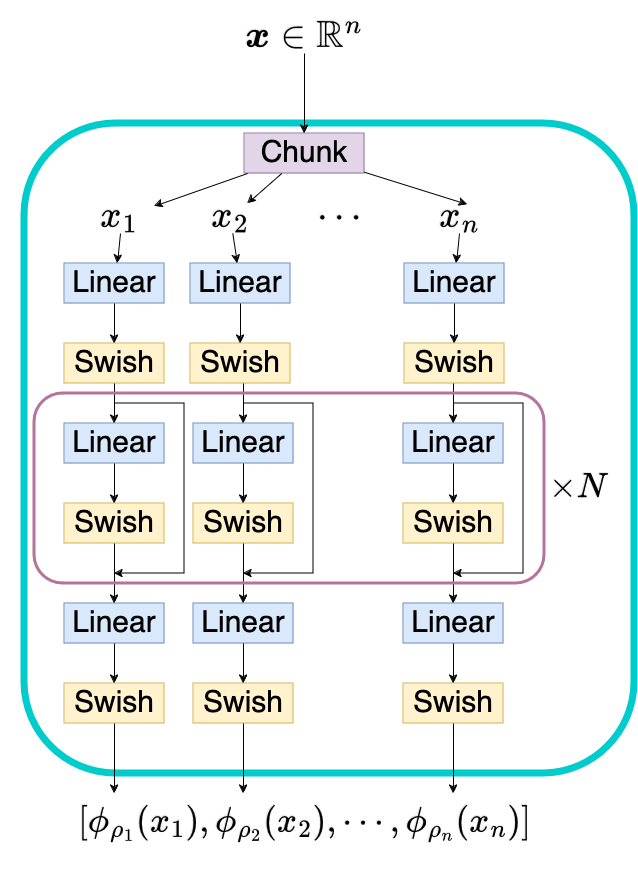
where \(\phi_{\rho_i}(x_i): \mathbb{R}\to\mathbb{R}^d\) and \(d\) is a number of basis (chunk_size).
Code
class CustomBasis(nnx.Module):
"""
Args:
num_chunks (int): degree of freedoms n
hidden_size (int): hidden layer size
chunk_size (int): number of basis for each mode
n_layers (int): number of hidden layers
rngs (nnx.Rngs): random generator
"""
def __init__(
self,
num_chunks: int,
hidden_size: int,
chunk_size: int,
n_layers: int,
x_scale: jax.Array,
rngs: nnx.Rngs,
):
self.num_chunks = num_chunks
self.hidden_size = hidden_size
self.chunk_size = chunk_size
self.n_layers = n_layers
self.x_scale = x_scale
initializer = jax.nn.initializers.glorot_uniform()
self.w_ini = nnx.Param(
initializer(
rngs.params(),
(self.num_chunks, self.hidden_size),
dtype=DTYPE,
)
)
self.b_ini = nnx.Param(
jnp.zeros((self.num_chunks, self.hidden_size), dtype=DTYPE)
)
self.w_mid = []
self.b_mid = []
for _ in range(n_layers):
self.w_mid.append(
nnx.Param(
initializer(
rngs.params(),
(self.hidden_size, self.hidden_size),
dtype=DTYPE,
)
)
)
self.b_mid.append(
nnx.Param(
jnp.zeros((self.num_chunks, self.hidden_size), dtype=DTYPE)
)
)
self.w_fin = nnx.Param(
initializer(
rngs.params(),
(self.hidden_size, self.chunk_size),
dtype=DTYPE,
)
)
self.b_fin = nnx.Param(
jnp.zeros((self.num_chunks, self.chunk_size), dtype=DTYPE)
)
def __call__(self, x: jax.Array, i: int | None = None) -> list[jax.Array]:
r"""
Args:
x (jax.Array): input position with shape (batch_size, DOFs)
i (int, optional): If you need only i-th basis $\phi_{\rho_i}$,
set this integer.
Returns:
list[jax.Array]: list of $\phi_{\rho_i}$ with length `num_chunks`.
Each basis has shape `(chunk_size,)`.
"""
if i is None:
index: slice = slice(0, x.shape[1])
else:
index: slice = slice(i, i + 1)
if x.ndim == 1:
x = x[:, jnp.newaxis] # batch, 1
elif x.ndim == 2:
assert x.shape[1] == 1
else:
raise ValueError(f"{x.ndim=} is invalid")
ndim = x.shape[1]
x = x / self.x_scale[jnp.newaxis, index]
x = (
self.w_ini[jnp.newaxis, index, :] * x[:, :, jnp.newaxis]
) # batch, num_chunks, hidden_size
x = x + self.b_ini[jnp.newaxis, index, :]
x = nnx.swish(x)
for i in range(self.n_layers):
res = x
x = x @ self.w_mid[i] # batch, num_chunks, hidden_size
x = x + self.b_mid[i][jnp.newaxis, index, :]
x = nnx.swish(x) + res
x = x @ self.w_fin # batch, num_chunks, chunk_size
x = x + self.b_fin[jnp.newaxis, index, :]
x = nnx.swish(x)
phi_chunked_array = jnp.split(x, ndim, axis=1)
phi_chunked_list = [item.squeeze(1) for item in phi_chunked_array]
return phi_chunked_list
x = jnp.arange(3 * 2).reshape(2, 3)
basis = CustomBasis(
num_chunks=3, hidden_size=4, chunk_size=2, n_layers=3, x_scale=x.std(axis=0),rngs=nnx.Rngs(0)
)
print(basis(x=x))
print(basis(x=x[:, 0:1], i=0))[Array([[ 0. , 0. ],
[-0.27816969, -0.27609677]], dtype=float64), Array([[0.16544799, 0.16702912],
[0.47790957, 0.3542889 ]], dtype=float64), Array([[ 0.67407335, 0.36907104],
[ 0.45613932, -0.21072378]], dtype=float64)]
[Array([[ 0. , 0. ],
[-0.27816969, -0.27609677]], dtype=float64)]Define Custom Model including the Custom Basis
Code
class CustomModel(nnx.Module):
"""
Args:
num_chunks (int): degree of freedoms n
hidden_size (int): hidden layer size
chunk_size (int): number of basis for each mode
n_layers (int): number of hidden layers
rngs (nnx.Rngs): random generator
"""
def __init__(
self,
num_chunks: int,
hidden_size: int,
chunk_size: int,
n_layers: int,
x_scale: jax.Array,
rngs: nnx.Rngs,
):
self.num_chunks = num_chunks
self.hidden_size = hidden_size
self.chunk_size = chunk_size
self.n_layers = n_layers
self.basis = CustomBasis(
num_chunks=self.num_chunks,
hidden_size=self.hidden_size,
chunk_size=self.chunk_size,
n_layers=self.n_layers,
x_scale=x_scale,
rngs=rngs,
)
def __call__(self, x: jax.Array, W: list[jax.Array], norm: jax.Array):
"""
Args:
x (jax.Array): input position with shape (batch_size, DOFs)
W (list[jax.Array]): list of tensor train core.
Each core has shape (bond_dim1, chunk_size, bond_dim2).
norm (jax.Array): Scalar which scales outputs.
"""
basis = self.basis(x)
return _forward_basis2y(basis=basis, W=W, norm=norm)
model = CustomModel(
num_chunks=3, hidden_size=16, chunk_size=2, n_layers=16, x_scale=x_samples.std(axis=0), rngs=nnx.Rngs(0)
)
nnx.display(model)CustomModel(
num_chunks=3,
hidden_size=16,
chunk_size=2,
n_layers=16,
basis=CustomBasis(
num_chunks=3,
hidden_size=16,
chunk_size=2,
n_layers=16,
x_scale=Array(shape=(3,), dtype=float64),
w_ini=Param(
value=Array(shape=(3, 16), dtype=float64)
),
b_ini=Param(
value=Array(shape=(3, 16), dtype=float64)
),
w_mid=[Param(
value=Array(shape=(16, 16), dtype=float64)
), Param(
value=Array(shape=(16, 16), dtype=float64)
), Param(
value=Array(shape=(16, 16), dtype=float64)
), Param(
value=Array(shape=(16, 16), dtype=float64)
), Param(
value=Array(shape=(16, 16), dtype=float64)
), Param(
value=Array(shape=(16, 16), dtype=float64)
), Param(
value=Array(shape=(16, 16), dtype=float64)
), Param(
value=Array(shape=(16, 16), dtype=float64)
), Param(
value=Array(shape=(16, 16), dtype=float64)
), Param(
value=Array(shape=(16, 16), dtype=float64)
), Param(
value=Array(shape=(16, 16), dtype=float64)
), Param(
value=Array(shape=(16, 16), dtype=float64)
), Param(
value=Array(shape=(16, 16), dtype=float64)
), Param(
value=Array(shape=(16, 16), dtype=float64)
), Param(
value=Array(shape=(16, 16), dtype=float64)
), Param(
value=Array(shape=(16, 16), dtype=float64)
)],
b_mid=[Param(
value=Array(shape=(3, 16), dtype=float64)
), Param(
value=Array(shape=(3, 16), dtype=float64)
), Param(
value=Array(shape=(3, 16), dtype=float64)
), Param(
value=Array(shape=(3, 16), dtype=float64)
), Param(
value=Array(shape=(3, 16), dtype=float64)
), Param(
value=Array(shape=(3, 16), dtype=float64)
), Param(
value=Array(shape=(3, 16), dtype=float64)
), Param(
value=Array(shape=(3, 16), dtype=float64)
), Param(
value=Array(shape=(3, 16), dtype=float64)
), Param(
value=Array(shape=(3, 16), dtype=float64)
), Param(
value=Array(shape=(3, 16), dtype=float64)
), Param(
value=Array(shape=(3, 16), dtype=float64)
), Param(
value=Array(shape=(3, 16), dtype=float64)
), Param(
value=Array(shape=(3, 16), dtype=float64)
), Param(
value=Array(shape=(3, 16), dtype=float64)
), Param(
value=Array(shape=(3, 16), dtype=float64)
)],
w_fin=Param(
value=Array(shape=(16, 2), dtype=float64)
),
b_fin=Param(
value=Array(shape=(3, 2), dtype=float64)
)
)
)Extract required arguments from TensorTrain modules
Initialize tensor train.
See also pompon.layers.tt.TensorTrain.
Code
2.738025133756779 [Array([[[ 0.269559 , 0.48521447],
[-0.66477019, -0.49998546]]], dtype=float64), Array([[[-2.69638259, 0.02057865],
[ 6.39613801, -0.46289717]],
[[-1.33265668, -0.4078536 ],
[ 5.44471885, 0.45414894]]], dtype=float64), Array([[[-0.47058099],
[ 0.88235681]],
[[-0.88235681],
[-0.47058099]]], dtype=float64)]
[Array([[-1.12089883e-02, 4.54244220e-01],
[-3.01759052e-47, 4.94457722e+00]], dtype=float64), Array([[-2.47008425e-01, -2.40598015e-01],
[-2.47244541e-19, -4.38226713e-02]], dtype=float64), Array([[-8.55275875e-18, 5.79409551e-01],
[-8.68260031e-86, -1.70533086e-02]], dtype=float64)]
[[ 0.71465496]
[-0.06264489]]Train with energy
Train basis with fixed tensor-train
Visualize basis
Code
def show_basis(model, tt):
x0 = np.linspace(-1, 1, 100)
x = np.zeros((100, 3))
x[:, 0] = x0
basis = model.basis(jnp.array(x))
for i in range(model.chunk_size):
plt.plot(x0, np.array(basis[0][:, i]), label=f"basis-{i}")
plt.plot(x0, x0**2, label="true")
norm, W = get_norm_W(tt)
y = model(jnp.array(x), W, norm)
plt.plot(x0, np.array(y.squeeze(1)), label="prediciton")
plt.legend()
plt.xlabel("$x_1$")
plt.ylabel("Energy")
plt.show()
show_basis(model, tt)
Train basis iteratively
Show training trace
Train tensor train with fixed basis
See also pompon.optimizer.sweeper.sweep.
Signature: sweep( *, tt: pompon.layers.tt.TensorTrain, basis: list[jax.Array], y: jax.Array, nsweeps: int = 2, maxdim: int | list[int] | numpy.ndarray = 30, cutoff: float | list[float] | numpy.ndarray = 0.01, optax_solver: optax._src.base.GradientTransformation | None = None, opt_maxiter: int = 1000, opt_tol: float | list[float] | numpy.ndarray | None = None, opt_lambda: float = 0.0, onedot: bool = False, use_CG: bool = False, use_scipy: bool = False, use_jax_scipy: bool = False, method: str = 'L-BFGS-B', ord: str = 'fro', auto_onedot: bool = True, ) Docstring: Tensor-train sweep optimization Args: tt (TensorTrain): the tensor-train model. basis (list[Array]): the basis functions. y (Array): the target values. nsweeps (int): The number of sweeps. maxdim (int, list[int]): the maximum rank of TT-sweep. cutoff (float, list[float]): the ratio of truncated singular values for TT-sweep. When one-dot core is optimized, this parameter is not used. optax_solver (optax.GradientTransformation): the optimizer for TT-sweep. Defaults to None. If None, the optimizer is not used. opt_maxiter (int): the maximum number of iterations for TT-sweep. opt_tol (float, list[float]): the convergence criterion of gradient for TT-sweep. Defaults to None, i.e., opt_tol = cutoff. opt_lambda (float): the L2 regularization parameter for TT-sweep. Only use_CG=True is supported. onedot (bool, optional): whether to optimize one-dot or two-dot core. Defaults to False, i.e. two-dot core optimization. use_CG (bool, optional): whether to use conjugate gradient method for TT-sweep. Defaults to False. CG is suitable for one-dot core optimization. use_scipy (bool, optional): whether to use scipy.optimize.minimize for TT-sweep. Defaults to False and use L-BFGS-B method. GPU is not supported. use_jax_scipy (bool, optional): whether to use jax.scipy.optimize.minimize for TT-sweep. Defaults to False. This optimizer is only supports BFGS method, which exhausts GPU memory. method (str, optional): the optimization method for scipy.optimize.minimize. Defaults to 'L-BFGS-B'. Note that jax.scipy.optimize.minimize only supports 'BFGS'. ord (str, optional): the norm for scaling the initial core. Defaults to 'fro', Frobenuis norm. 'max`, maximum absolute value, 'fro', Frobenius norm, are supported. auto_onedot (bool, optional): whether to switch to one-dot core optimization automatically once the maximum rank is reached. Defaults to True. This will cause overfitting in the beginning of the optimization. File: ~/GitHub/Pompon/pompon/optimizer/sweeper.py Type: function
Repeat tensor train optimization & basis optimization
Code
tx = optax.adam(1e-5)
optimizer = nnx.Optimizer(model, tx)
for i in tqdm(range(10000)):
if i % 500 == 0:
norm, W = get_norm_W(tt)
basis = model.basis(x_samples)
sweep(
tt=tt,
basis=basis,
y=y_samples,
nsweeps=1,
maxdim=2,
opt_maxiter=200,
# optax_solver=optax.adam(1.e-04),
use_CG=True,
onedot=False,
auto_onedot=False,
)
norm, W = get_norm_W(tt)
loss = train_step(model, optimizer, x_samples, y_samples, W, norm)
losses.append(loss)Train with forces
Train basis with fixed tensor-train
Define function that returns \(-\frac{\partial V}{\partial x}\) by auto differentiation
Code
from functools import partial
def get_force(x, model, norm, W):
def func(x, model, norm, W):
if x.ndim == 1:
# When no-batch
x = x[jnp.newaxis, :]
return -1.0 * model(x, norm=norm, W=W).squeeze(0)
else:
return -1.0 * model(x, norm=norm, W=W)
ener_fn = partial(func, model=model, norm=norm, W=W)
jacobian = jax.vmap(jax.jacrev(ener_fn))(x) # (batch, out, in)
return jacobian.squeeze(-2) # (batch, in)Define train_step which has a loss function \[ \mathcal{L} = \frac{1}{2|\mathcal{D}|} \sum_{\boldsymbol{x}, E, \boldsymbol{F} \in \mathcal{D}} \left[\left(\hat{V}(\boldsymbol{x})-V\right)^2 + \left(\hat{\mathbf{F}}(\boldsymbol{x})-\mathbf{F}\right)^2\right] \]
Code
@nnx.jit
def train_step(model, optimizer, x, y, f, W, norm):
def _loss_fn(model):
pred = model(x, W, norm)
loss = jnp.mean((pred - y) ** 2)
pred_force = get_force(x, model, norm, W)
loss += (
jnp.sum((pred_force.flatten() - f.flatten()) ** 2)
/ pred_force.shape[0]
)
return loss
loss, grads = nnx.value_and_grad(_loss_fn)(model)
optimizer.update(grads)
return lossCheck train_step works
Train basis iteratively
Code
Train tensor train with fixed basis
Prepare basis gradient \(-\frac{\partial \Phi}{\partial x_i}\)
Code
def get_partial_basis(x, i, model):
assert x.ndim == 2 # batch, dim
x = x[:, i : i + 1]
def func(x, model):
if x.ndim == 1:
x = x[jnp.newaxis, :]
return -1.0 * model.basis(x, i)[0].squeeze(0)
else:
return -1.0 * model.basis(x, i)[0]
basis_fn = partial(func, model=model)
# since in=1 < out=number of basis, we should use forward differentiation
jacobian = jax.vmap(jax.jacfwd(basis_fn))(x) # batch, out, in
return jacobian.squeeze(2) # batch, out
partial_basis_i = get_partial_basis(x_samples, 0, model)partial_basis= $ $
basis= \(\left[\phi_{\rho_1}, \phi_{\rho_2}, \cdots, \phi_{\rho_n} \right]\)
concat_y=\(y_p\) where \(p=k \otimes i\) \[
y_p = y_i^{(k)} =
\begin{cases}
\boldsymbol{F}_i^{(k)} & \mathrm{for} \quad i \leq n \\
E^{(k)} & \mathrm{for} \quad i = n+1
\end{cases}
\]
Code
(1024, 1)basis_list= \[
\begin{bmatrix}
[\partial_{x_1}\phi_{\rho_1} & \phi_{\rho_2} & \cdots & \phi_{\rho_n} ], \\
[\phi_{\rho_1} & \partial_{x_2}\phi_{\rho_2} & \cdots & \phi_{\rho_n} ], \\
& & \vdots & & \\
[\phi_{\rho_1} & \phi_{\rho_2} & \cdots & \partial_{x_n}\phi_{\rho_n} ], \\
[\phi_{\rho_1} & \phi_{\rho_2} & \cdots & \phi_{\rho_n} ]
\end{bmatrix}
\]
concat_basis= $ $ where \[
\varphi_{\rho_j}^p = \varphi_{i, \rho_i}^{(k)} =
\begin{cases}
-\partial_{x_j}\phi_{\rho_j} & \mathrm{for} \quad i=j \\
\phi_{\rho_j} & \mathrm{otherwise}
\end{cases}
\]
Code
def get_concat_basis(x: jax.Array, model: CustomModel) -> list[jax.Array]:
"""
Args:
x (jax.Array): postions
model (CustomModel): model
Returns:
list[jax.Array]: derivative concatenated basis
"""
partial_basis = [get_partial_basis(x, i, model) for i in range(x.shape[1])]
basis = model.basis(x)
basis_list = []
for i in range(len(basis)):
basis_row = [
ϕ.copy() if k != i else dϕ.copy()
for k, (ϕ, dϕ) in enumerate(zip(basis, partial_basis, strict=True))
]
basis_list.append(basis_row)
basis_list.append(basis)
concat_basis = [
jnp.vstack([φ[i] for φ in basis_list]) for i in range(len(basis))
]
return concat_basis
concat_basis = get_concat_basis(x_samples, model)
print(concat_basis[0].shape)(1024, 2)Train tensor train with fixed basis
Only basis & y are changed from energy optimization.
Code
Repeat tensor train optimization & basis optimization
Code
tx = optax.adam(1e-5)
optimizer = nnx.Optimizer(model, tx)
for i in tqdm(range(10000)):
if i % 500 == 0:
norm, W = get_norm_W(tt)
concat_basis = get_concat_basis(x_samples, model)
sweep(
tt=tt,
basis=concat_basis,
y=concat_y,
nsweeps=1,
maxdim=2,
opt_maxiter=200,
# optax_solver=optax.adam(1.e-04),
use_CG=True,
onedot=True,
auto_onedot=False,
)
norm, W = get_norm_W(tt)
loss = train_step(
model, optimizer, x_samples, y_samples, f_samples, W, norm
)
losses.append(loss)Access optimized tensor train cores
0 Core(shape=(1, 2, 2), leg_names=('β0', 'i1', 'β1'), dtype=float64)
[[[-0.23738906 -0.24130501]
[-0.93898443 0.06104555]]]
1 Core(shape=(2, 2, 2), leg_names=('β1', 'i2', 'β2'), dtype=float64)
[[[-0.58550331 0.05419654]
[ 0.80821735 0.03214547]]
[[-0.8099358 -0.07141367]
[-0.57994308 -0.05069637]]]
2 Core(shape=(2, 2, 1), leg_names=('β2', 'i3', 'β3'), dtype=float64)
[[[-0.99307731]
[ 0.11746261]]
[[ 0.11746261]
[ 0.99307731]]]